Crafting Harmony: Designing a Successful Multi-Functional Indoor/Outdoor Space
In the realm of modern living, the distinction between indoor and outdoor spaces is becoming increasingly blurred. Homeowners seek to seamlessly integrate the two, creating versatile areas that cater to a variety of activities and functions. Whether you have a sprawling backyard or a cozy balcony, designing a successful multi-functional indoor/outdoor space requires thoughtful planning and creativity. Here are some practical tips to help you craft a harmonious environment that effortlessly transitions between the indoors and outdoors.
1. Define Your Purpose
Before diving into the design process, take some time to define the purpose of your indoor/outdoor space. Consider how you envision using the space—will it be a tranquil retreat for relaxation, an entertainment hub for hosting gatherings, or a functional workspace for getting out in nature, but also being productive? Identifying your primary goals will guide the design decisions and layout of the space, ensuring that it meets your needs and enhances your lifestyle.
2. Create Seamless Transitions
To achieve a sense of continuity between the indoors and outdoors, aim for seamless transitions in both design and functionality. Choose materials, colors, and furnishings that complement each other and blur the boundaries between the two spaces. Use sliding glass doors, large windows, or folding walls to create open-air connections that allow for easy flow between indoor and outdoor areas. By breaking down barriers and embracing fluidity, you can maximize the usability and visual appeal of your multi-functional space.
3. Consider Climate and Seasonality
When designing an indoor/outdoor space, it's essential to consider the climate and seasonal changes in your region. Incorporate elements that provide comfort and protection from the elements, such as retractable awnings, pergolas, or outdoor heaters. Select durable materials and furnishings that can withstand exposure to sun, rain, and wind, ensuring longevity and resilience over time. Additionally, think about ways to adapt the space for different seasons, whether it's adding cozy blankets and cushions for winter or incorporating shade and cooling elements for summer.
4. Embrace Versatile Furnishings
Versatility is key when it comes to furnishing a multi-functional indoor/outdoor space. Choose furniture pieces that serve multiple purposes and can easily transition between different activities and configurations. Look for modular seating arrangements, convertible tables, and lightweight accessories that can be moved and rearranged as needed. Opt for outdoor-friendly materials such as weather-resistant wicker, teak, or aluminum that can withstand exposure to the elements without sacrificing style or comfort.
5. Integrate Greenery and Natural Elements
Incorporating greenery and natural elements into your indoor/outdoor space can enhance its beauty, promote relaxation, and foster a connection to the outdoors. Integrate potted plants, vertical gardens, or hanging planters to add texture, color, and life to the space. Incorporate natural materials such as wood, stone, and bamboo to create a sense of warmth and authenticity. By blurring the lines between the built environment and nature, you can create a tranquil oasis that soothes the senses and rejuvenates the spirit.
6. Personalize with Lighting and Ambiance
Lighting plays a crucial role in setting the mood and ambiance of your indoor/outdoor space. Incorporate a mix of ambient, task, and accent lighting to create layers of illumination that cater to different activities and occasions. Consider installing outdoor string lights, lanterns, or torches to add warmth and intimacy to evening gatherings. Explore smart lighting solutions that allow you to adjust brightness and color temperature to suit your preferences and create the desired atmosphere.
In conclusion, designing a successful multi-functional indoor/outdoor space requires careful consideration of purpose, functionality, and aesthetics. By defining your goals, creating seamless transitions, considering climate and seasonality, embracing versatile furnishings, integrating greenery and natural elements, and personalizing with lighting and ambiance, you can create a harmonious environment that enhances your lifestyle and blurs the boundaries between the indoors and outdoors. So, roll up your sleeves, unleash your creativity, and transform your space into a versatile haven that seamlessly transitions between indoor coziness and outdoor allure.



